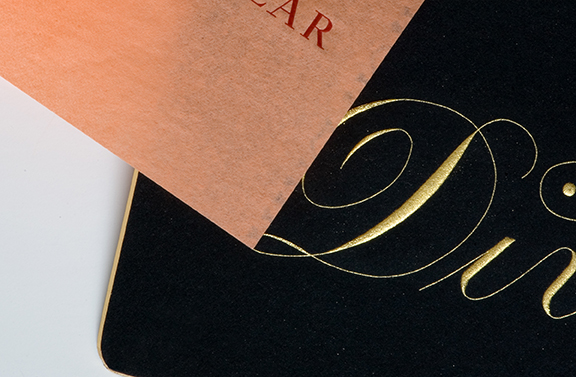A luxury.
It is also upon what we write to carry our messages through the mail. As you most likely know, examples of engraved social stationery are letterhead, note cards, correspondence cards, place and calling cards, and formal invitations (such as for weddings.) Imprinted on these may be family crests, seals, monograms, custom and elaborate script lettering. In the hands of a master engraving craftsperson, impressions can be made on a diversity of substrates from the thinnest to the thickest papers and card stock.

Engraving is also the preferred printing method for formal professional correspondence such as presidential inaugural invitations and invitations to the Vatican. In the words of Nancy Sharon Collins, stationer extraordinaire and author of the book The Complete Engraver published by Princeton Architectural Press:
“Engraving is a form of intaglio printing, the inverse of letterpress. Engraved letterforms and art stand proud above the paper surface and there’s a telltale bruise on the back.”

For those familiar with the more popular letterpress process, it is fair to say that engraving is the “outie” and letterpress the “innie” printing process.
Is it very desirable and if so, why?
There’s a visceral response while picking up a piece of engraved stationery. One can see and feel the high degree of craftsmanship that went into its making.
Engraving stationery is a meticulous discipline requiring hours and hours of hand labor. It must be performed by a highly skilled individual with a mastery of old-fashioned processes and technologies.
Most engraving presses (called die-stamping machines) are old. Some are more than a century old and still in use! While contemporary technology does aid in creating the original art for some engraving, engraving printing presses use no digitally driven automation or AI software. The engraving printing technology harkens back to the Second Industrial Revolution wherein a fly-wheel generates the action for producing multiple impressions. Two tons per square inch of force is required to print each impression on, for instance, each card in a set of notes. This process prints one color at a time. The artwork for it is prepared as line art. It must be 100% black on a white background with no color or grey areas. Large solid areas need to be treated in a specific way to appear as a solid.

After the artwork is prepared and approved by the client, it is transferred to a 1/4″ copper plate or is hand engraved on a 1/2″ thick steel die. Each is made to print one color during one press run at a time. Additional colors (including black) require separate art, a separate plate or die, and a separate press run.
Are there more differences between engraving and other forms of printing? Yes.
In addition to the distinctive look of the ink standing proud and the telltale bruise, another feature of engraved stationery is the fineness of the lines. Engraved lines can be the finest that the printing world has ever produced. For instance, the narrow strokes of hand-lettered, engraved script, and some serif lettering can all but disappear at the end of the stroke.
All of this requires meticulous care and mastery of craftsmanship allowing for precise detail and perfect reproduction.
Mrs. Collins likes to say that each press run—meaning each set of a client’s stationery—is an edition. Each piece is unique. A specimen of precious art created almost entirely by hand.
For more information about bespoke engraved social stationery and hand-drawn monograms and ciphers contact Mrs. Collins. She loves stationery inquiries of all kinds.